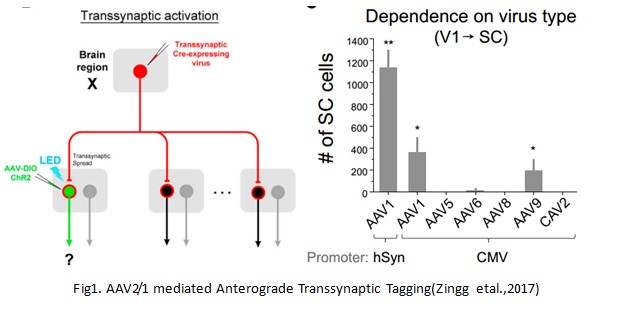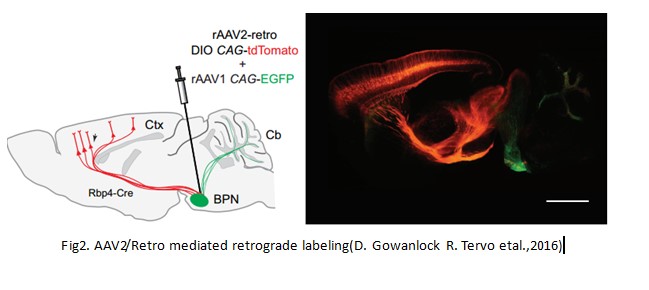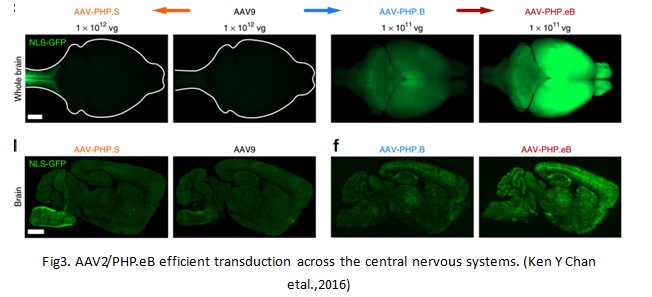Filter
Filter
June 22, 2024
by BrainVTA Admin
Choosing the Right AAV serotype

Aadeno-associated virus (AAV) have been identifed as a promising means for gene deliver. AAV tropism, as dictated by AAV capsid proteins, is an important factor affecting transduction efficiency and specificity across cell types. Consequently, serotype should be carefully considered
when designing experiments. This post will give you an overview of the primary used AAV serotype.
1.Anterograde labeling
AAV2/9 and AAV2/1 can be used for anterograde labeling of neurons. AAV2/9, which is non-transsynaptic (anterograde) and is often used in the study of neuronal projection. AAV2/1 is used to mediated Anterograde Transsynaptic Tagging, which can be selected when it is necessary to identify the neurons connected downstream. But there are conditions for AAV2/1 exhibits effective trans-synaptic (anterograde) transduction, that is AAV2/1 should paired with Cre and the titer should be ≥10^13vg/ml.

2.Retrograde labeling
AAV2/Retro is the only available serotype that used for retrograde labeling, which is non-transsynaptic, and is therefore available when exploring the source of projections neurons.

3.Gene delivery to the CNS
AAV vectors are powerful tools that are able to mediate gene transfer to the CNS. The structure of the brain is relatively complex and has many partitions, so the selection of AAV serotype should be determined according to the whole brain infection or local infection.
1.For the whole brain infection
Several natural AAV capsids cross the blood-brain barrier(BBB). By intravenous injections of AAV2/9 andAAV2/ rh.10 to neonatal mouse, the neurons can be transduced broadly across the CNS. However, the transduction is more limited when delivered to the adult. Now, the engineered AAV2/PHP.eB is more efficient to deliver gene to the central nervous systems. In the adult mouse, intravenous administration of 1 × 1011vg of AAV-PHP.eB transduced 69% of cortical
and 55% of striatal neurons.

2.Direct brain Delivery
When injected directly into the brain, many of the naturally occurring AAV capsids have distinct but significantly overlapping tropisms and distribution characteristics. AAV2/1, AAV2/2, AAV2/5, AAV2/8, AAV2/9 and the engineered AAV2/DJ are commonly used to target local populations of neurons after direct injections. AAV2/2 is mostly transduce neuronal, while AAV2/1, AAV2/5, AAV2/8 and AAV2/9 also transduce astrocytes and oligodendrocytes. At the same time, AAV2/2 diffusion is more confined and, therefore, serotype2 is often chosen for applications that require precise targeting.
4.Gene delivery to the PNS
Many peripheral neuron include dorsal root ganglia (DRG), nodose ganglia, sympathetic chain gangli, cardiac ganglia and the enteric nervous system. AAV-PHP.S, an improved version of serotype 9, is currently the best choice to infect the peripheral nervous system. 1 × 1012 vg of AAV-PHP.S transduced 82% of dorsal root ganglion neurons, as well as cardiac and enteric neurons.
Keep in mind, however, that no single serotype is 100% optimal for every tissue target. If you have any questions on which one to use, feel free to contact us at sales@brainvta.com; we’d be happy to assist you.
BrainVTA provide professional, convenient and R & D products experienced service of AAV, ranging from small-scale to the large-scale, which help scientist accelerate the research process in circuit tracing, mechanisms of disease and treatment of disease
Reference
1.Neuron.2017 Jan 4;93(1):33-47. PMID:27989459 Doi: 10.1016/j.neuron.2016.11.045.“AAV-Mediated Anterograde Transsynaptic Tagging: Mapping Corticocollicular Input-Defined Neural Pathways for Defense Behaviors”.
2.Neuron.October 19, 2016 A Designer AAV Variant Permits Efficient Retrograde Access to Projection Neurons.
3.nature neurosciences. 2017 Engineered AAVs for efficient noninvasive gene delivery to the central and peripheral nervous systems
when designing experiments. This post will give you an overview of the primary used AAV serotype.
1.Anterograde labeling
AAV2/9 and AAV2/1 can be used for anterograde labeling of neurons. AAV2/9, which is non-transsynaptic (anterograde) and is often used in the study of neuronal projection. AAV2/1 is used to mediated Anterograde Transsynaptic Tagging, which can be selected when it is necessary to identify the neurons connected downstream. But there are conditions for AAV2/1 exhibits effective trans-synaptic (anterograde) transduction, that is AAV2/1 should paired with Cre and the titer should be ≥10^13vg/ml.

2.Retrograde labeling
AAV2/Retro is the only available serotype that used for retrograde labeling, which is non-transsynaptic, and is therefore available when exploring the source of projections neurons.

3.Gene delivery to the CNS
AAV vectors are powerful tools that are able to mediate gene transfer to the CNS. The structure of the brain is relatively complex and has many partitions, so the selection of AAV serotype should be determined according to the whole brain infection or local infection.
1.For the whole brain infection
Several natural AAV capsids cross the blood-brain barrier(BBB). By intravenous injections of AAV2/9 andAAV2/ rh.10 to neonatal mouse, the neurons can be transduced broadly across the CNS. However, the transduction is more limited when delivered to the adult. Now, the engineered AAV2/PHP.eB is more efficient to deliver gene to the central nervous systems. In the adult mouse, intravenous administration of 1 × 1011vg of AAV-PHP.eB transduced 69% of cortical
and 55% of striatal neurons.

2.Direct brain Delivery
When injected directly into the brain, many of the naturally occurring AAV capsids have distinct but significantly overlapping tropisms and distribution characteristics. AAV2/1, AAV2/2, AAV2/5, AAV2/8, AAV2/9 and the engineered AAV2/DJ are commonly used to target local populations of neurons after direct injections. AAV2/2 is mostly transduce neuronal, while AAV2/1, AAV2/5, AAV2/8 and AAV2/9 also transduce astrocytes and oligodendrocytes. At the same time, AAV2/2 diffusion is more confined and, therefore, serotype2 is often chosen for applications that require precise targeting.
4.Gene delivery to the PNS
Many peripheral neuron include dorsal root ganglia (DRG), nodose ganglia, sympathetic chain gangli, cardiac ganglia and the enteric nervous system. AAV-PHP.S, an improved version of serotype 9, is currently the best choice to infect the peripheral nervous system. 1 × 1012 vg of AAV-PHP.S transduced 82% of dorsal root ganglion neurons, as well as cardiac and enteric neurons.
Keep in mind, however, that no single serotype is 100% optimal for every tissue target. If you have any questions on which one to use, feel free to contact us at sales@brainvta.com; we’d be happy to assist you.
BrainVTA provide professional, convenient and R & D products experienced service of AAV, ranging from small-scale to the large-scale, which help scientist accelerate the research process in circuit tracing, mechanisms of disease and treatment of disease
Reference
1.Neuron.2017 Jan 4;93(1):33-47. PMID:27989459 Doi: 10.1016/j.neuron.2016.11.045.“AAV-Mediated Anterograde Transsynaptic Tagging: Mapping Corticocollicular Input-Defined Neural Pathways for Defense Behaviors”.
2.Neuron.October 19, 2016 A Designer AAV Variant Permits Efficient Retrograde Access to Projection Neurons.
3.nature neurosciences. 2017 Engineered AAVs for efficient noninvasive gene delivery to the central and peripheral nervous systems
